Anzio and The Devil’s Brigade – Fact or Fiction?
This is the seventh post reporting on a tour of Canadian battle sites in Italy with LiberationTours and their excellent team of historian Mark Zuehlke, interpretive guide and raconteur extraordinaire Phil Craig and just plain John Cannon, the best trip organizer you’ll ever travel with. We have just finished touring the sites in Sicily, the last post ending at Agira Canadian War Cemetery, where 484 Canadian men are buried. The next morning we hopped on a short flight from Catania to Rome and headed south to the now sleepy little harbour port of Anzio. This post will describe the role that Canadians played in the drawn out affair that was the Allied landing that got bogged down for months thanks to the timidity of one man. Although for reasons that will follow, a number of people on our tour are quite knowledgable about the Canadians at Anzio, I must confess that until today, I was not one of them. That is not to say I did not know about Anzio, but it was from a combination of reading historical accounts and, more honestly, two Hollywood movies.
Anzio – The Hollywood Version
WW II resulted in some of the greatest war movies ever made. Think no further than The Longest Day, The Bridge on the River Kwai or The Great Escape. By the mid 1960’s, epic movies like these were being replaced by movies that featured specialized groups doing heroic, if implausible deeds. Think of The Dirty Dozen or Von Ryan’s Express. 1968 saw the release of two movies about Anzio, which fit into each of the two categories above. Neither was a critical or commercial success at the time, but I do remember watching both and that’s where my initial impressions of the Anzio landings were formed.
Anzio was based on a book of the same name written by BBC war correspondent Wynford Vaughn-Thomas who was at the Anzio landings. Naturally, the role of correspondent (and hero) was changed to an American, played by the great actor Robert Mitchum. Despite a good cast, the movie never really takes off and veers from concentrating on the big picture. Apparently it was true that a group actually did drive all the way to Rome and back, proving that the area between Anzio and Rome was lightly defended so the Allies did not need to dig in, as they in fact did, with disastrous consequences. Instead it concentrates on another disaster, the rout of the U.S. Ranger units at Cisterna, arguably the worst defeat in U.S. military history. Of almost 800 Rangers who left on the mission only 7 returned. The rest were killed or became POWs.
I think the makers of Anzio were tiptoeing into the waters of making a movie that was openly critical of U.S. decision making and veering away from the traditional jingoistic approach to WWII movies up to then. They chickened out. Two years later that taboo was shattered by M.A.S.H., although it was the Korean War and not WWII.
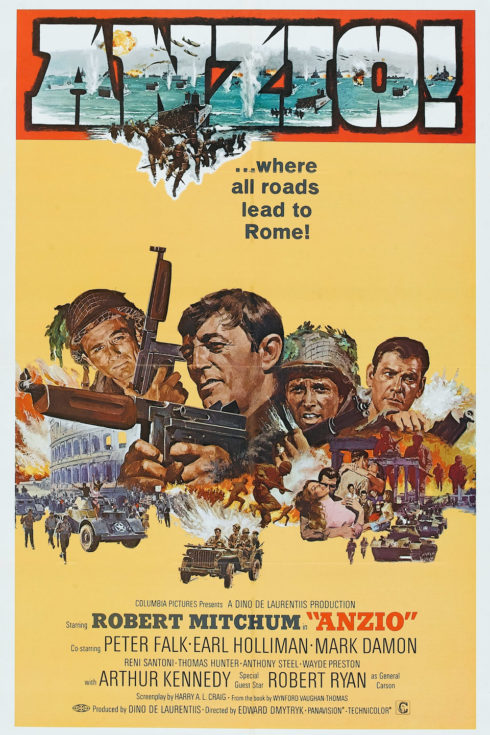
The Devil’s Brigade is a different kettle of fish and much more relevant to the reason our group is at Anzio today. It tells the story (or at least pretends to, as best Hollywood ever can) of the 1st Special Service Force which was the only joint U.S./Canadian military operation in history. Like Anzio it had a great cast including Oscar winners William Holden and Cliff Robertson. Have a look at the movie poster. Note the red berets they never wore, but the V- 42 combat knives they did really carry.
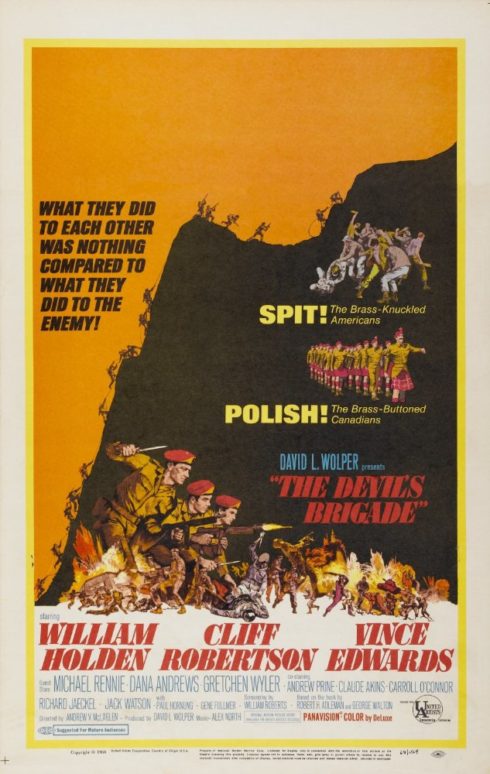
The Yanks are depicted as a group of brawling, criminal hooligans and the Canucks as ultra straight disciplined soldiers. Blend the two and you get a fighting force that is invincible. Watch this video and have a good laugh. You can fast forward to the middle to see the Canadians arriving, accompanied by our drums and bagpipes. Has to be the only Hollywood movie ever where Canadian values might trump those of the U.S.A.
The movie deals primarily with events that preceded the Anzio landings and I’ll discuss these when I get to the history of the real Devil’s Brigade, but first the truth about Anzio.
Anzio – Indecision Costs Thousands of Lives
In the last post I left off the end of the campaign in Sicily with a visit to Agira Canadian War Cemetery and the reader might wonder what happened between that campaign and the Allies now preparing to land just south of Rome. Very quickly, the Allies failed to stop the Germans from successfully evacuating across the Straits of Messina and saving most of their troops to fight a rearguard action up the toe of Italy. The Allies were hot on their heels, landing on the mainland on September 3, 1943 and following it up with American landings at Salerno on September 9. The Germans established a number of defensive lines that stretched across the width of Italy, determined to extract a huge cost in Allied lives to break through these lines. After initial successes, the invasion got bogged down at the most heavily fortified and easily defended line across Italy, the Gustav line.
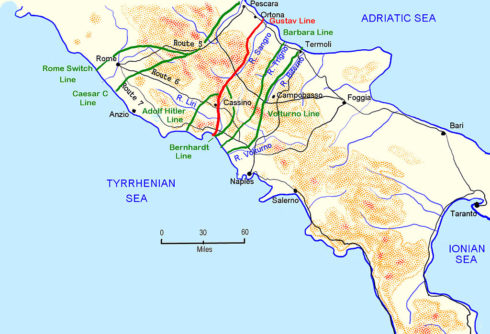
The Gustav line is drawn in red, perhaps representing the fact that it was an effective stop light for advancing Allied forces where the Barbara, Bernhardt and Volturno lines had not. At the Adriatic side of the line is the town of Ortona and close to the western end is the town of Cassino. I will be visiting both in upcoming posts as they are both significant places in the Canadian campaign in Italy. On the map you can see Anzio on the German side of the Gustav Line. It was a not especially important little fishing village that did have a series of beaches that could provide landing spots for a seaborne invasion.
Who the architect behind the Anzio invasion actually was, is a matter of debate. Given the fact that it was almost completely unsuccessful in achieving its objectives, it’s not surprising that no one wanted credit. There is no doubt that Churchill was one of the prime proponents and given the fact that he was the author of the disastrous Gallipolli landing in WWI, it’s no wonder that the idea was greeted with skepticism. This was especially so of the Americans who were the ones who would supply most of the troops and supplies. However, Churchill got his way and Major General John P. Lucas was put in charge.
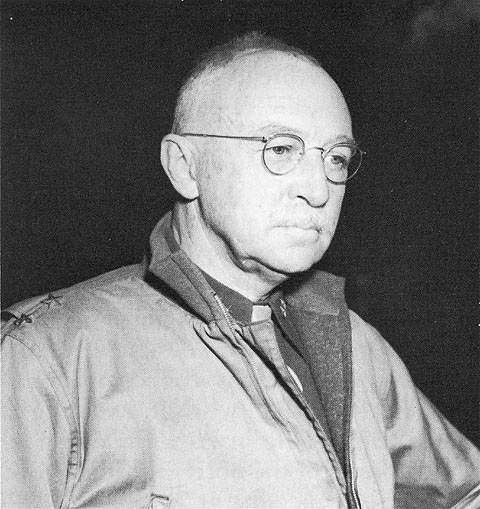
However, it’s important to keep in mind that Lucas took his orders from General Mark Clark who was head of the U.S. Fifth Army that was bogged down at the Gustav Line. Clark was not particularly sold on the idea of Anzio which, simply put, was to put the squeeze on the Gustav Line defenders by putting a huge Allied force behind. They would have no choice but to withdraw troops from the Gustav Line, thus weakening it to the point it could be breached. Alternatively, the Anzio troops could march north and capture a largely undefended Rome, for a huge symbolic victory. Instead, Lucas did neither. His 36,000 troops faced little resistance during the landing and instead of heading inland he decided to dig and wait for reinforcements. The reinforcements did arrive and upped his men to 69,000, but still he did nothing. Churchill famously bemoaned, “I had hoped we were hurling a wildcat into the shore, but all we got was a stranded whale.”
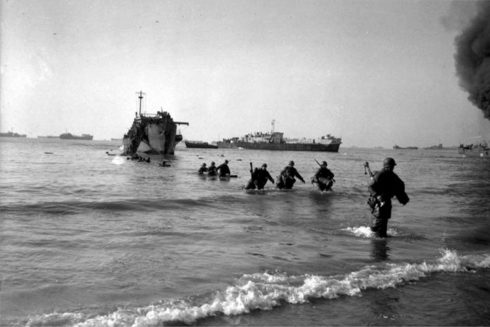
The Germans, amazed at the Allies’ timidity, were able to bring up over 70,000 of their own forces to pin down Lucas, which they did very effectively. However, German counterattacks were thwarted with Anzio developing into a deadly stalemate that produced enormous casualties on both sides. The stalemate lasted from January to June when the Allies finally broke through, not because of what happened at Anzio, but because the Gustav Line was finally broken. The cost was almost 30,000 casualties including 4,400 killed. Lucas was replaced near the end of the campaign, but by then it was too late to prevent what many believed was a needless carnage. For example Audie Murphy, the most decorated U.S. serviceman of all time and star of many Saturday matinee westerns I watched as a kid, refused to shake Lucas’ hand when he showed up on one of Murphy’s sets, commenting, ” too many damned good men died at Anzio and Nettuno because of that son of a bitch.”
So, in a nutshell, Anzio was an Allied failure, but what about the role that Canadian’s played if any? That’s where the Red Devils come in.
The Devil’s Brigade
The First Special Service Brigade was the only joint U.S./Canadian unit ever created and was the forerunner of elite Special Forces units that exist to this day in both the American and Canadian military service. Think of the Navy Seals or the Delta Force in the U.S. and the awkwardly named Canadian Special Operations Forces Command (CANSOFCOM) in Canada. These guys were meant to be the best of the best and still are. The badge of today’s Canadian forces has the motto viam inveniemus which roughly translated means, ‘we will find a way’ and that is what they do.
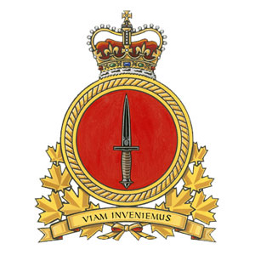
The First Special Service Brigade was an entirely volunteer unit composed of 1,800 men who possessed a unique skill set that included prowess in survival skills, marksmanship, use of knives, swimming ability and anything else that could prove useful in ‘behind the lines’ operations. Not surprisingly these were the type of things that Canadian backwoodsmen excelled in. Likewise the Americans, who, contrary to the movie, were not a bunch of ungovernable hooligans, which would have been the very opposite of what Lt. Col. Robert Frederick, the commander of the unit, would be looking for.
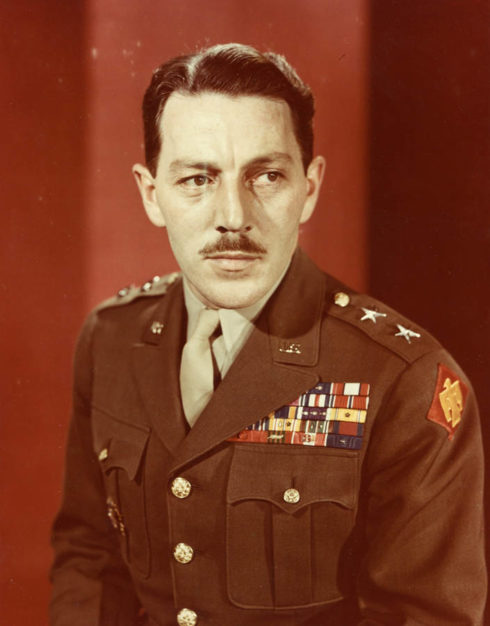
Frederick, who became revered by his men, (contrast that to Lucas), put them through rigorous training at a remote site in Fort Harrison, Montana. Interestingly, two members of our tour had recently visited Fort Harrison and sported T-shirts with the Devil’s Brigade logo, on our visit to Anzio. I have added it to my list of must visit military sites.
Frederick also participated in the design of the vaunted V-42 knife which became a trademark killing weapon of the Special Forces. Today, there are few of these knives in existence and collectors pay a lot of money for them.
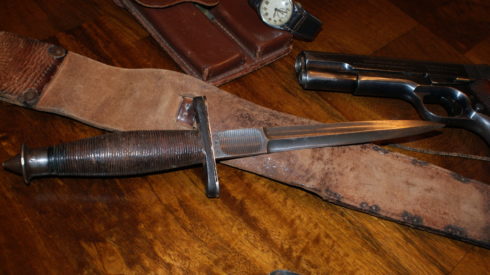
Frederick also ensured that the unit had a unique shoulder patch that identified it as a joint U.S./Canadian team.
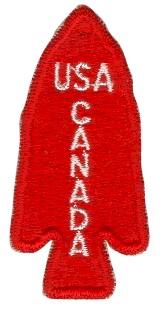
The First Special Service Force was ready for action by July 1943 and made its initial debut on the Aleutian Island of Kiska, of all places, which had been occupied by Japanese forces in June 1942. Few people know that the Japanese actually invaded American territory during WWII, but by the time the Special Force arrived the Japanese had evacuated. They were next sent to Italy, where they arrived in November, 1943, ready for action. It was here that the legend of the Devil’s Brigade began.
Monte la Difensa was a previously impenetrable German position near Monte Cassino that had cost many British and American lives attempting to scale the cliffs that made it a such a daunting defensive stronghold. Watch this video made by the government of Canada and find out how the Devil’s Brigade earned its reputation. This was also the basis for the movie.
After Monte la Difensa the Special Forces successfully took three more mountain top strongholds in just over a month, suffering an incredible 77% casualty rate. This was all before anybody had landed at Anzio. After the landings, the Special Forces were deployed to Anzio to replace the U.S. Rangers who had been decimated at Cisterna (the basis of the Anzio movie). This is where they gained the fearsome reputation among the Germans as the Devil’s Brigade or the ‘black devils’. They left trademark stickers on dead Germans that included the red brigade patch and the slogan “Das dicke Ende kommt noch,” which translated to, “The worst is yet to come”. They fought for 99 straight days and were the first unit to actually enter Rome, although the egomaniac Mark Clark would deny this. For reasons that don’t make a lot of sense, the Devil’s Brigade was disbanded in France in 1944, but their legend will never forgotten. We are here in Anzio today to honour the Canadians who fought and died as part of the Devil’s Brigade.
Liberation Tour 2016 at Anzio
Our visit to Anzio was fleetingly short, but extremely informative. It started with a group meeting at the Anzio monument on the waterfront of this quiet Italian seaport.
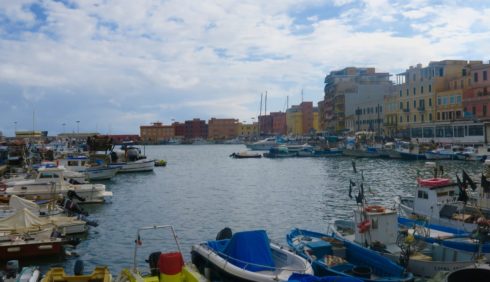
Mark Zuehlke and Phil Craig provided us with much of the information about the Anzio landings and the role the Devil’s Brigade played there.
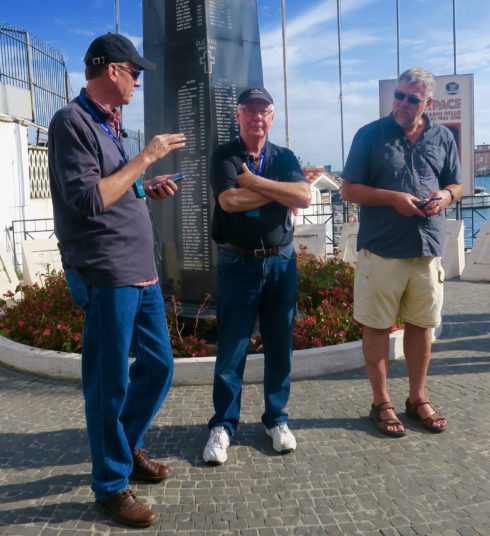
This was followed by a talk by Neil Staff, one of tour members, on the evolution and history of the V-42 Combat knife. Note his T-shirt with the Devil’s Brigade insignia. Afterwards, one of the guys who had visited Fort Harrison prior to the trip handed out pins for everyone with the trademark red spear badge of the Devil’s Brigade. I was proud to attach it to my Liberation Tours hat now that I knew the true history of this vaunted unit and the role that Canadians played in it.
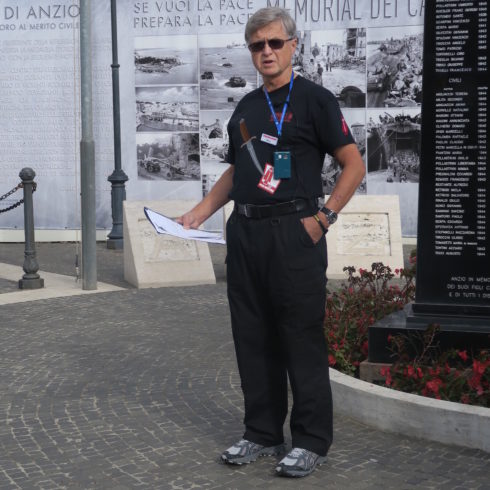
It was then time for a group photo before boarding the bus for the short trip to Beach Head War Cemetery.
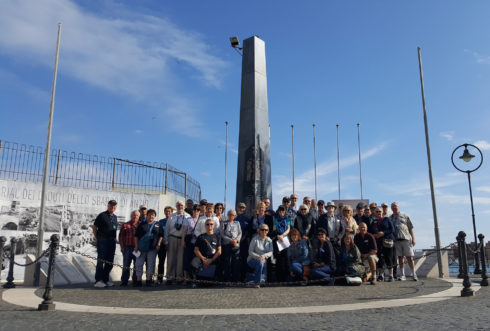
Beach Head War Cemetery
Beach Head War Cemetery is on the outskirts of Anzio and is the final resting place of 2,316 Commonwealth soldiers who died during the Anzio campaign. Although primarily British, I would be looking for Canadian members of the First Special Service Brigade. Before going our separate ways to look for individual graves we met at the Stone of Remembrance which is a feature of any Commonwealth War Cemetery which has more than 1,000 burials, which is why we didn’t see one at Agira. Designed by Sir Edwin Luytens and is intended to commemorate men of all faiths or none. These monuments are always the same and always moving in their simplicity and solidity.
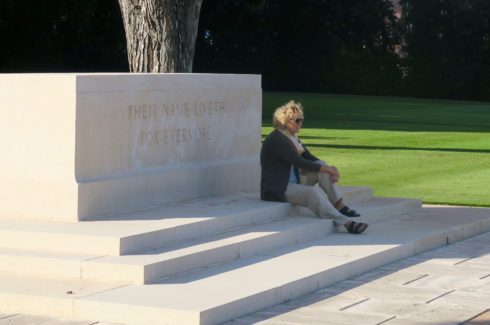
We gathered around the monument and Mark told us the story of Thomas (Tommy) Prince, the most decorated aboriginal soldier in Canadian history. Follow the link to learn more about this amazing man and the feats he accomplished at Anzio and elsewhere. He received both the British Military Medal and the American Silver Star along with nine other medals. He is buried in Brookside Cemetery in Winnipeg and next time I’m there I’m definitely going to pay him a visit.
Like all CWGC cemeteries, Beach Head is beautiful in its symmetry and upkeep. The umbrella pines in the background immediately identify it as an Italian location.
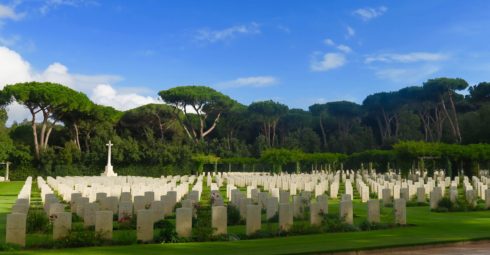
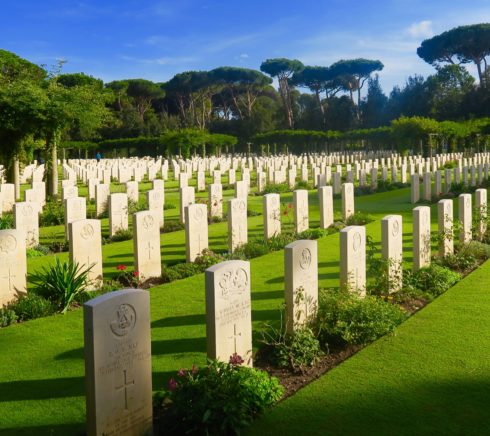
It was now time to each search out graves of those we wished to honour. Here are a few, in no particular order, that I think are interesting.
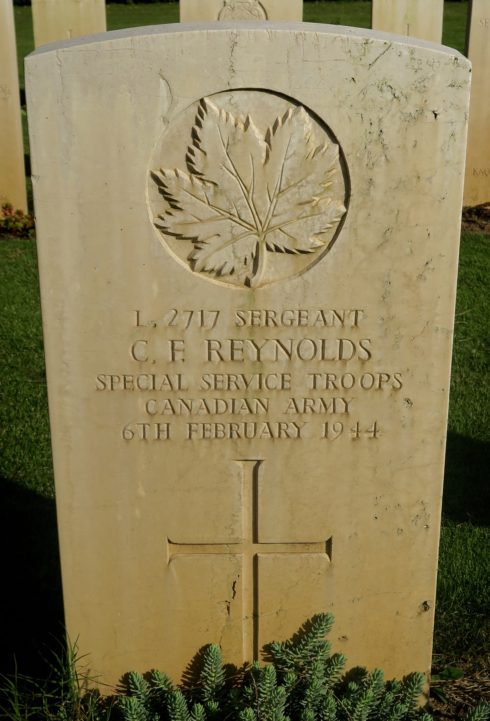
This is Sgt. Charles Frederick Reynolds, son of Mr. and Mrs. W.J. Reynolds of Foam Lake, Saskatchewan.
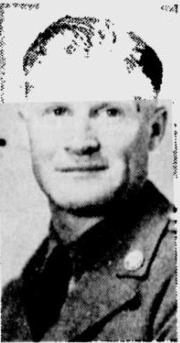
Fred was a member of the Devil’s Brigade, killed at Cassino on February 6, 1944. As noted in the obituary he had two other brothers in the service when he was killed.

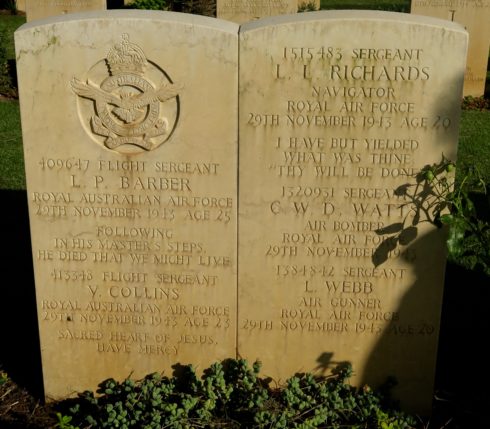
This is a sight that is all too common in these cemeteries – an entire flight crew killed on November 29, 1943.
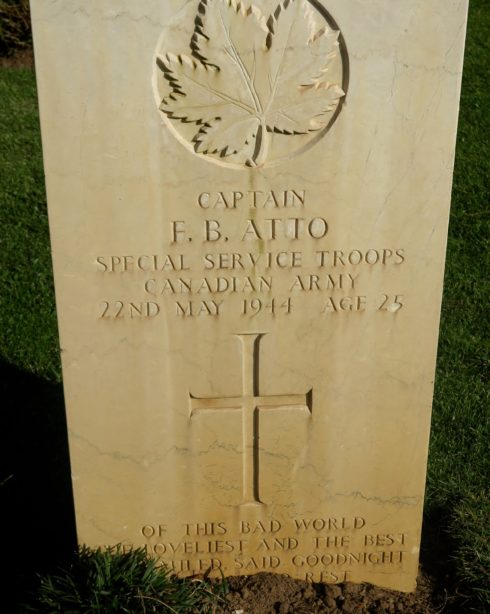
This is another member of the Devil’s Brigade, Captain Frederick Blake Atto, son of Frederick and Daisy Atto of Mount Royal, Quebec.
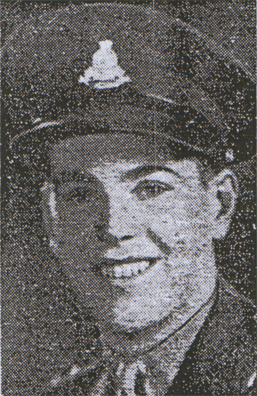
Captain Atto was killed on May 22, 1944 and what is doubly tragic is that his brother, Major Clayton Howard Atto, also a member of the Canadian Special Service Brigade, was killed in Algeria on the same day. How the parents could overcome something like this is beyond my comprehension.

Lt. Ernest Jean Fortune, also a Devil’s Brigade member, was the son of James and Catherine Fortune of Victoria, B.C. I can find nothing more about him.
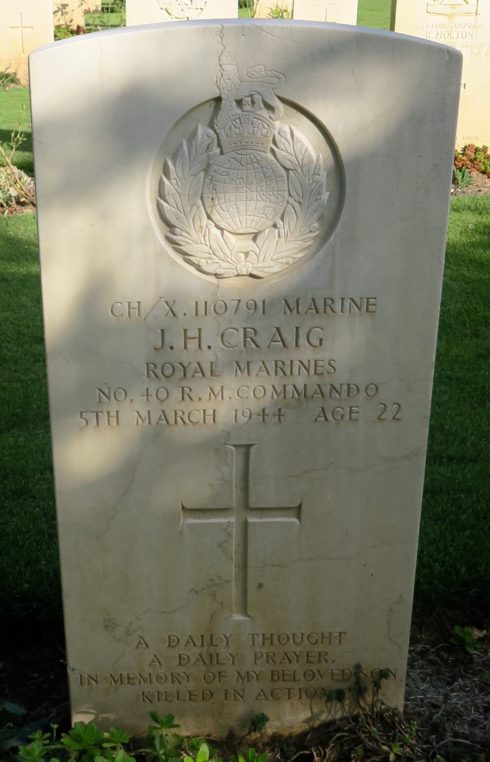
Here is the final resting place of the British equivalent to our Special Forces, a Marine Commando, who were also an all volunteer unit of elite fighting specialists.
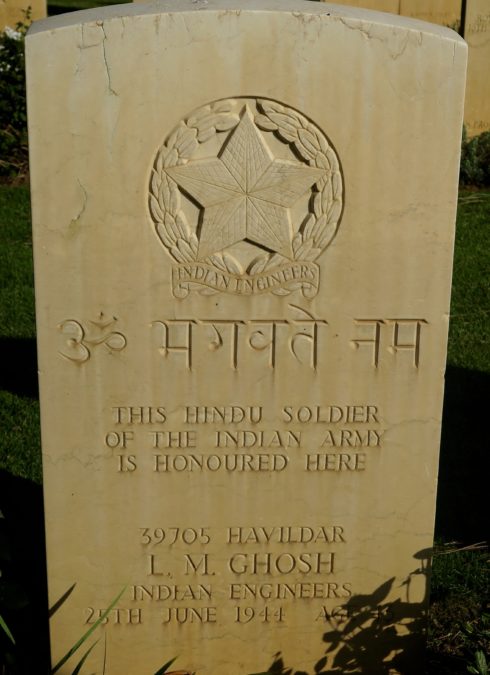
This a soldier from the Indian army holding the rank of havildar which is the equivalent of sergeant. He was the son of Nritakali Devi and husband of Sovana Ghosh of Calcutta. From reading Mark’s books on the Italian campaign I learned that the Indian army played a major role and fought alongside the Canadians in numerous battles.
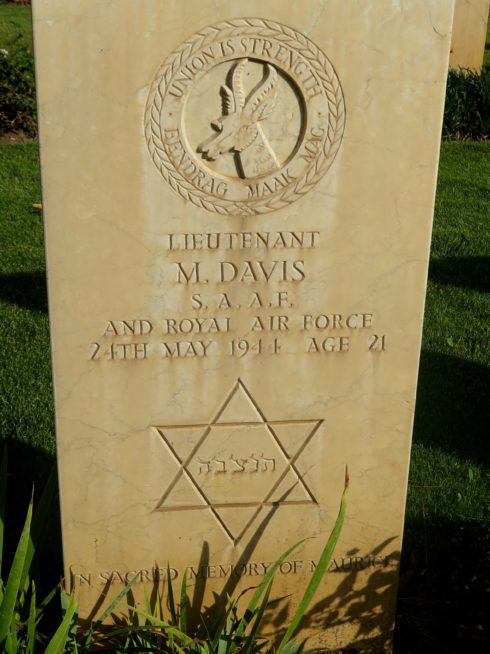
This is the marker for Maurice Davis, son of Samuel and Dinah Davis of Johannesburg, South Africa. It is an example of both the South African springbok which is used like the maple leaf, on all South African graves and the Star of David used for those of the Jewish faith.
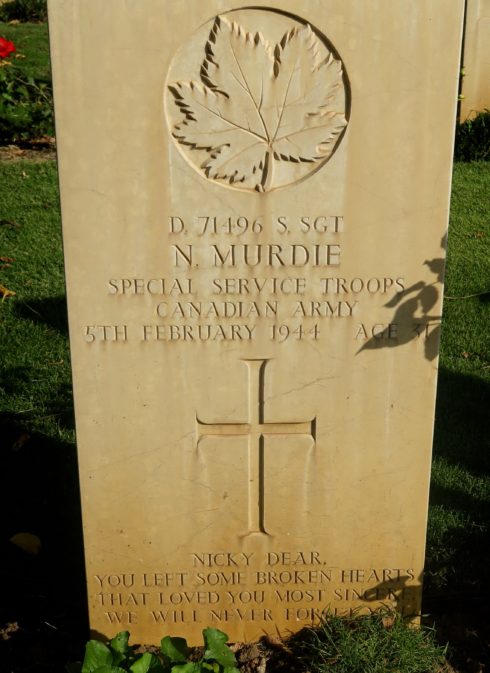
Another Special Forces grave – Staff Sergeant Nicholas Murdie from Verdun, Quebec. His next of kin is listed as an aunt, Johanna Novorol, but based on the inscription he left behind some broken hearts.
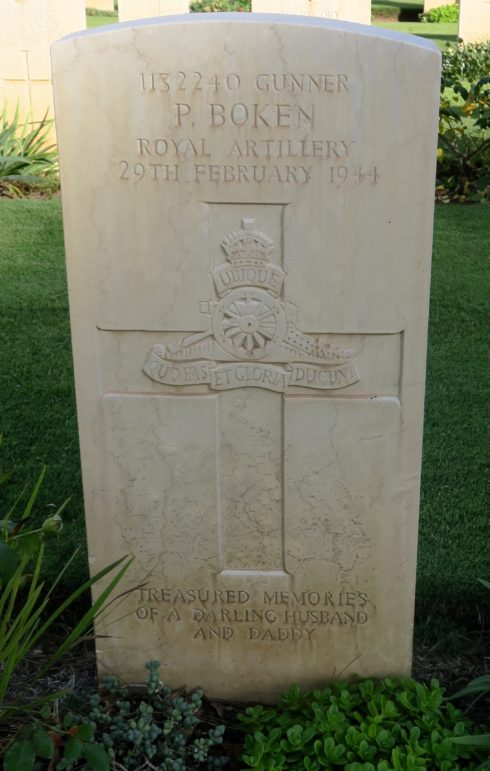
Gunner Patrick Boken of St. Helens, Lancashire left behind not just his parents James and Mary Kate Boken, but a wife Elizabeth and child.
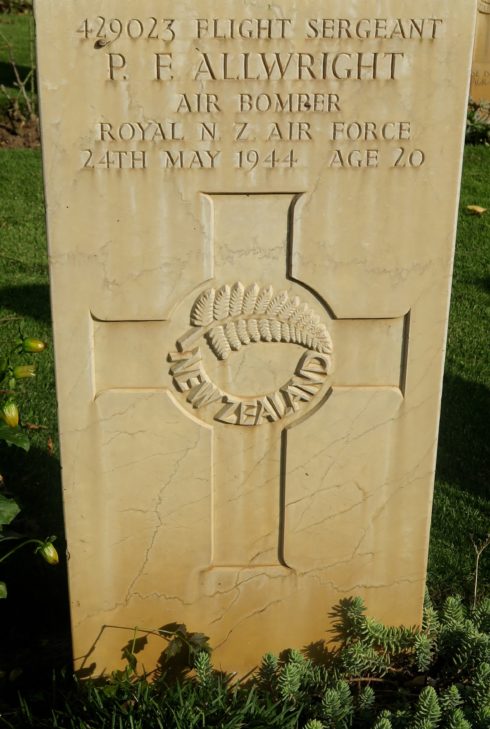
Lastly this is the grave of Flight Sergeant Peter Francis Allwright son of Robert and Doris Allwright of Wellington, New Zealand with the silver fern which graces all Kiwi graves.
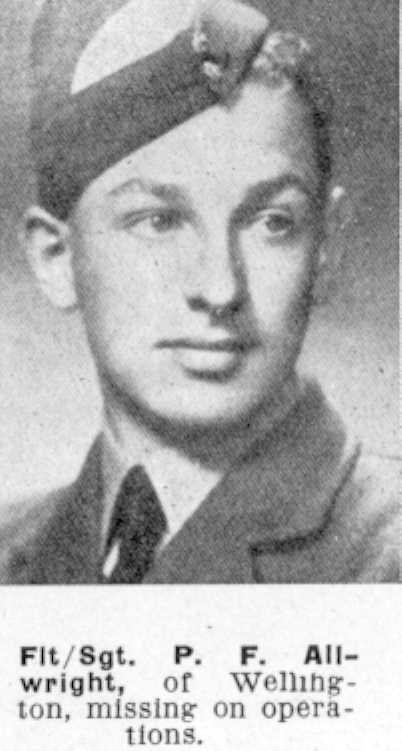
The one thing that should be clear from these various graves is that WWII was truly a world war and members of the Commonwealth played a significant role, suffering devastating casualties. Also, whether you were a member of all faiths or no faith, it made no difference as to whether you lived or died.
With the sun getting low we head back to the bus, most teary eyed, I look back and notice yellow roses, a symbol of optimisim, growing between the graves and can only hope that we have not entered a new era of fascism.
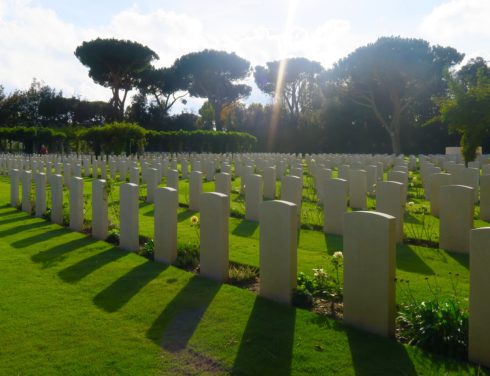
So that’s the story of Anzio and the Devil’s Brigade. Next we’re off to Ortona where the Canadians fought the Germans in house to house combat. I hope you’ll join us.

